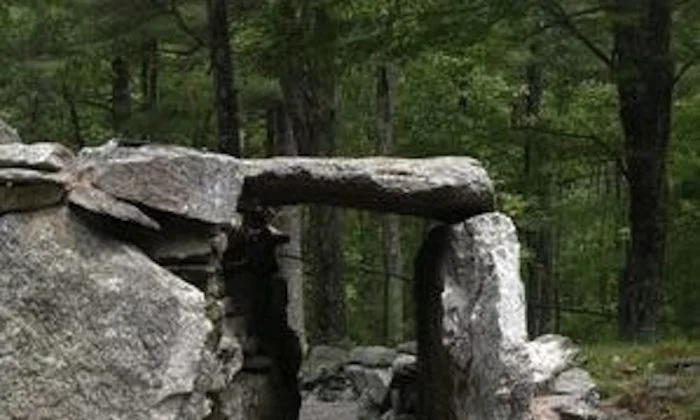Mysterious Megaliths in Lovecraft's New England
Just a few weeks ago we spun a (mostly) true tale of occult happenings in early colonial America just a few miles from the more famous Puritan colonies at Plymouth rock. We're just tipping our toes into October, that oh-so-traditional month of horror and decorative gourds, and so it doesn't seem right to abandon our (again, mostly) real account of megalithic stone constructions that predate the arrival of English and Dutch settlers to the American Northeast (though it remains unclear if they were there before the arrival of the vampires). Admittedly, we've briefly touched on this subject before, when we joined amateur (or maybe, more appropriately, untainted) archaeologist Jim Vieira in speculating that they represented evidence of a powerful race of giants who lived alongside -- and in some cases ruled -- the human Native American tribes of both New England and the Mississippi Valley until they mysteriously died out. If Mr. Vieira is correct, the scientific establishment, up to and including the Smithsonian, has an almost infinite willingness to obscure inconvenient scientific discoveries. Might this have been concealed as part of a similar cover-up? Regardless, they are certainly all great places to set adventures -- or at least encounters -- in your game, whether filled with dubious pulp archaeology or cosmic horror. Each or any may hold the key to an ages-old plot, or draw the attentions of a forgotten god down onto the heads of your unsuspecting players. Given the reference material, this is probably almost ideal inspiration for a Trail of Cthulhu (or Call of Cthulhu, or even Delta Green) game, but it could be easily repurposed to just about anything with a need for suspiciously ancient ruins not far from the densely populated Bos-Wash corridor.
Stone Circles and Artificial Caves
The stone circle at Mount Dagon was not the first to be built on American shores, nor even the first to be built in the wooded hollows of New England. Indeed, several other sites boasted substantial stone constructions believed to substantially predate English settlement of the region. The Mystery Hill megalithic complex, more popularly known as “America’s Stonehenge,” in Salem, New Hampshire, is perhaps the best known today. Mystery Hill shares a variety of astronomical alignments and structural similarities with several other megalithic sites scattered across the region, including the Slate Hill complex between Attica and Chorazin, New York, and the subterranean tunnel system at Pratt Hill in Upton, Massachusetts. Carbon-dating indicates that the earliest constructions at all three sites may be more than 4,000 years old, a theory given credence by the discovery of inscriptions using Phoenician characters within some of the underground chambers at the Mystery and Slate Hill sites.
Although only the Mystery and Pratt Hill complexes are open to the public (Slate Hill is on a private estate closed to the public since 1935), all three sites are known to contain hewn stones likely used as sacrificial altars, aligned with solar equinoxes and solstices and, perhaps more significantly, the rising and setting of the Hyades star cluster circa 900 to 2300 BCE. Although the possibility that Algonquian or Iroquois tribes — or the native populations they supplanted — constructed the sites to support their own ceremonial needs should not be discounted, oral traditions of the Pennecook Native American tribe which occupied the area through the mid-1600s speak of the sites as if they were already old when their earliest ancestors settled the lands around it, fueling theories of pre-Columbian European or even pre-Human construction.
Rings of megalithic standing stones at Burnt Hill near Heath and at Sentinel Hill above Dunwich, Massachusets were constructed with some of the same astronomical alignments, and Sentinel hill in particular is famed for the curiously grooved round stone at it’s center, likely used in the same forgotten sacrificial rites once performed in prehistoric Salem, Chorazin, and Upton. A similar site is said to have stood on a hill in the center of Kingsport until 1644, when it was demolished and the Old Reformed Church was built on the same site. Nevertheless, both the Chorazin and Upton constructions lack the complex construction and subterranean features of the better known locales in New York and New Hampshire, and the church grounds where the rumored Kingsport megaliths stood are not open to archaeological exploration.
Lost Pre-Columbian Construction in the Bridgewater Triangle
The most architecturally advanced of the prehistoric megalithic sites in New England is also the least accessible: the infamous Round Tower, situated on a small island in the Miskatonic River’s meandering pathway through the Hockomock Swamp. Twelve feet in diameter and twenty feet high, the tower is unique among superficially similar megalithic sites in its complex construction, and though as yet not fully surveyed, its foundations are rumored to plunge several hundred feet down into the granite bedrock, storing a great treasure of some forgotten tribe of giants, Norse wanderers fleeing some disaster of lost Vinland, refugee Templar, or more likely the Wampanoag, who used the swamp as a redoubt throughout their and their Narraganset allies’ war against the English from 1675 to 1678, if indeed it exists at all. For all the uncertainty of its legendary treasure, the site’s occult history is well documented. As Steven Reinhart relayed in his 1979 Brief History of the Miskatonic Valley,
“The tower is said to have been the site of devil worship as far back as colonial times, serving as a place of worship to exiled shaman and white sorcerers. The same site is well-recorded in the annals of the now long-abandoned town of Gardner, where it was reputed to have served as an altar ‘where the devil himself held court under a sky of queer and disturbing color.’ More recently, the site is reputed to have been responsible for several disappearances and murders, themselves attributed to a cult allegedly using the entire Hockamock region as a refuge, with the Round Tower serving as a sort of ceremonial center for cult activity.”
The fact that these megalithic sites served some kind of ceremonial or religious purpose to whoever built them is hardly in dispute, but their true nature remains a mystery. Modern occultists have repeatedly alleged that the sites lie at the central intersections of telluric currents that crisscross the area, potentially offering those who know how to harness the power at the center of the stones the ability to shape and control vast geomagnetic energy streams which meet within the networks of tunnels and standing stones. It is possible that at least some of these structures were designed to harness these energies imprison or contain some kind of spirit or entity, focusing the corrupting influence of these unnatural beings with greater intensity in small areas in order to make the vast tracts of land around them safe for human habitation.
Yet, the prevalence of strange lights in the skies above and around the sites and their histories of unexplained disappearances may offer a third possibility: that these temples were meant as beacons for extra- (or ultra-) terrestrial beings who had long frequented the area — neutral points where ancient humans could meet or summon the strange creatures in trade, worship, or both. The malign influence and relatively dense grouping of these megaliths may help explain why the Native American nations who populated the area had not developed the complex ritual structures like those of the Ohio and Mississippi Valleys, but may have also helped isolate them from the socio-cultural collapse that had destroyed those same civilizations by 1400 CE.
True Purposes?
It is also likely no coincidence that several of these sites proved to be significant draws for religious rejectionists and refugees fleeing the witch trials that swept through New England beginning in the 1640s. For example, the settlement that became Chorazin, New York, began as an unofficial colony of Dutch and English settlers who established farmsteads and plantations to the south and west of Slate Hill in 1660, led by a Dutch planter named Dirck Van der Heyl who had been expelled from his family’s holding around Albany for marrying an English woman who, to add insult to injury, was herself an accused witch fleeing prosecution in the English colonies to the East.




